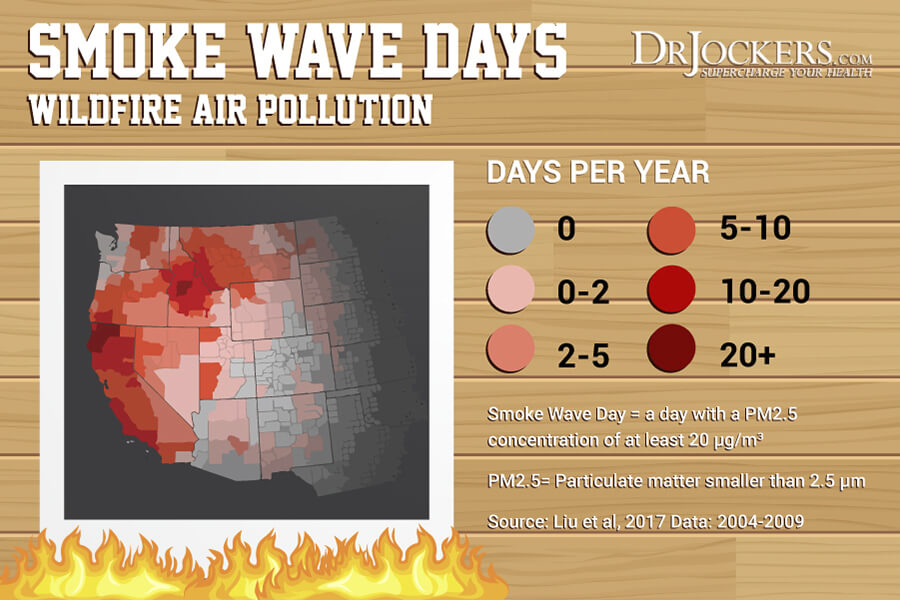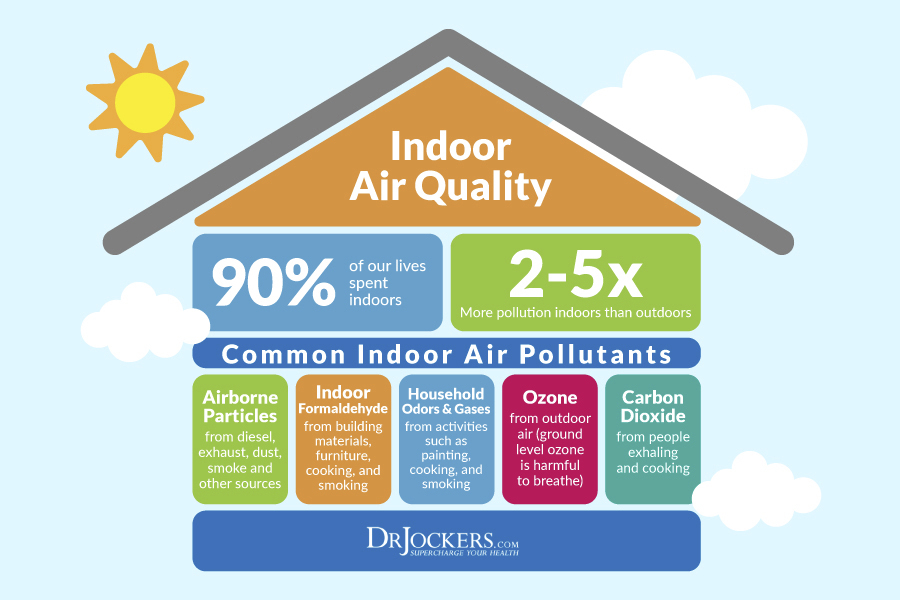 Smoke Exposure: Protection from Wildfire Smoke
Smoke Exposure: Protection from Wildfire Smoke
Every year there are a number of significant wildfires leading to both environmental devastation and significant health issues for those exposed. Last year, 66,131 total fires burned 9,781,062 acres of land. 2018 saw complete wreckage in the California area, with the United States declaring a state of emergency due to the roaring California fires (1).
The Mendocino Complex Fire became the largest recorded fire complex in California history. It led to a significant impact on the overall air quality of not only California but its neighboring states and even parts of Canada as well. Anyone living in these areas was subjected to smoke exposure and its health risks for an extended period.
This article will go into the risks of smoke exposure and how you can protect yourself.
Wildfires produce a substantial amount of smoke. This smoke carries a toxic mixture of gases and fine particles that come from both burning wood and plant material. This toxic mixture of gases and particulate matter taints the air quality and negatively affects the health of those who breathe it.
What can you do to protect yourself, your health, and your home from the potentially dangerous smoke exposure from a wildfire? Most importantly what are the significant health effects that can potentially plague a person who has experienced both short-term and long-term smoke exposure?

Wildfire Seasons Correlation to Health Risks
Does wildfire season elicit an increase in health risks in the exposed population? One can assume that high levels of smoke are never good for human health, and large, roaring wildfires are substantial proof of this claim. When smoke levels are high, and the smoke is composed of both hazardous gas mixtures and fine particulate matter, even healthy individuals may be subjected to symptoms and health effects.
Wildfire season, depending on the number of wildfires occurring and in which areas are affected – different health risks may be possible to those in the environment. A major culprit of health issues within wildfire smoke is the fine particulate matter that is carried throughout the wildfire smoke.
PM, or Particulate Matter, are particles that can both irritate and cause health issues within the body. Health effects from PM can vary based on a couple different factors including the type of plants burning, atmospheric conditions, and the size of the particles within the wildfire smoke.
Particulate matter larger than 10 micrometers usually will cause irritation to the eyes, nose, and throat. Whereas fine particulate matter 2.5 micrometers or smaller will potentially be ingested into the deepest area of the lungs, and lead to significant health effects.

How Do Wildfires Start
Did you know that as many as 90% of wildland fires in the United States are started by humans? Most human-caused wildfires are elicited from either camp fires left unattended, from burning debris, discarded cigarettes, or even an intentional arson attack. Although this is the main cause of wildfires, other sources could include mother nature like lightning strikes that can ignite a wildfire or even the dry climate in areas like the Northwest United States.
In recent years, dry weather conditions have led to a desirable condition for wildfires to take place on – increasing the risk factor of these fires. These hot conditions can make the ground more likely to burn, therefore on a hot day, the rising temperatures can create the ideal path for a wildfire to travel up and burn faster. According to maps from FEMA, wildfires statistically occur more frequently in the Western parts of the U.S. – particularly in areas with dry or drought-like conditions like California, Nevada, Idaho, or Oregon.
 Wildfire Smoke Exposure Health Effects
Wildfire Smoke Exposure Health Effects
The complexity of wildfire smoke makes the potential list of health effects exhaustive and unpredictable. Many factors come into play when exposure to wildfire smoke occurs – length of exposure, amount of smoke in the air, and preexisting health conditions present to those who are exposed. Those who are afflicted with other health conditions such as those with heart or lung disease, as well as children and the elderly are at an increased risk of health effects from wildfire smoke.
Children breathe in more air per pound of their body weight than adults, therefore they are at a greater risk of inhaling polluted, hazardous wildfire smoke that is in the air. Also, women who are pregnant can be at a significant health risk from wildfire smoke exposure, along with their developing fetus.
With every year that passes, health effects from wildfire smoke increase. Researchers who examined the health impacts of U.S. wildfires from 2008 to 2012 found that up to 8,500 people are sent to the hospital with smoke-related respiratory issues annually. Dr. Andrew Ordon stated, “If you inhale too much smoke, it can lead to respiratory failure and you’re not exchanging oxygen and carbon dioxide the way you’re supposed to” (2).

Wildfire Smoke Inhalation Symptoms
Wildfire smoke contains soot and ash that will rain down over the affected environments for many days following a wildfire. For many wildfires, the reach of its effects on the air quality of neighboring areas is quite probable and thus even those who are not directly impacted should be careful and prepared.
The soot, ash, and particulate matter can impact those with asthma, emphysema, COPD, or those suffering from heart disease. Depending on the amount of smoke, length of exposure, and standing health, these symptoms could occur from wildfire smoke exposure:
- Coughing
- Trouble breathing normally
- Stinging eyes
- A scratchy throat
- Runny nose
- Irritated sinuses
- Wheezing and shortness of breath
- Chest pain
- Headaches
- An asthma attack
- Tiredness
- Fast heartbeat

Masks for Smoke Exposure
Reducing outdoor smoke exposure during and following a wildfire is important. One helpful way of doing this is wearing a mask. However, do not rely on paper or dust masks for protection. This will not provide full protection from all components of wildfire smoke. Instead, try utilizing an effective wildfire smoke filter mask like the EnviroKlenz Face Mask.
Most face masks simply do not work to combat the gases and odors released from the smoke of a wildfire, therefore having both a face mask that can neutralize and break down both gases and odors, as well as filter out particulate matter can be essential when dealing with hazardous wildfire smoke.
How to Protect Yourself & Your Home from Wildfire Smoke
The effects of wildfire smoke exposure can impact everyone differently but preventing and minimizing wildfire smoke exposure is a must! Depending on where you live, certain preparations are needed – particularly for those who live in the Northwestern United States like California, Montana, Oregon, & Colorado.
Wildfire smoke is heavy and can spread quickly and rapidly and your home is no exception. What can you do to shield your home and yourself from the potentially harmful effects of wildfire smoke?

Stay Indoors
If there are wildfires where you live then being outside will obviously increase your smoke exposure. Being inside will help to mitigate some risks by lowering the amount of smoke you are exposed to. Using the smoke mask mentioned above will be helpful when you must leave the house.
For maximum protection, you will want to also use an indoor air purification system. This is because, not only can smoke make its way inside, but indoor air is often very polluted.

Take Precautions for Kids
During a wildfire, children should be carefully shielded from the hazards of wildfire smoke. Children’s lungs are still developing; therefore, they may be more susceptible to long-term damage from smoke exposure. Be sure to reduce your child’s outdoor exposure. This means to limit or completely eliminate their outdoor playtime until air quality improves.
Developing lungs makes it even more important to take steps to provide high-quality indoor air for children. This is especially important for those living in states where wildfires are more common. As you can see in the graphic below, wildfire smoke exposure is just adding insult to injury. This is due to the common indoor air pollutants we deal with on a regular basis.

Roll Up Car Windows
Wildfire smoke can easily make its way into your car. There are two things you should do to minimize your smoke exposure while driving:
- Keep windows closed
- Set your air condition to the “recirculation” setting so that it does not pull in outdoor air
Protect the Air in Your Home
Bunker down! Close doors, windows, and fireplace dampers in your home for protection and preventiveness of wildfire smoke. Wildfire smoke can be invasive – therefore be sure to limit outdoor air intake within the walls of your home.
If, however, wildfire smoke enters into your home you may want to consider investing in a wildfire smoke air purifier. Many air purification devices are not capable of dealing with the multiple components of wildfire smoke. The EnviroKlenz Mobile Air System is a one-in-a-kind air purification device that is able to effectively work against all the components of wildfire smoke with both a proprietary technology air filter for gas, chemical, and odor removal, as well as a hospital-grade HEPA filter for particulate removal.
Wildfire smoke can significantly impact the health of many that have been exposed! Taking preventive measures can help you to reduce your risk of wildfire smoke exposure.




